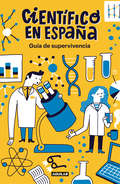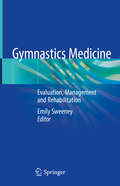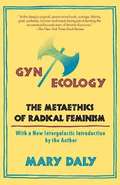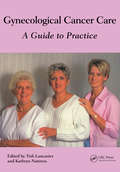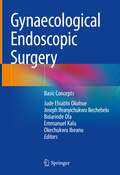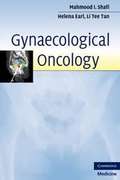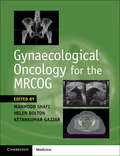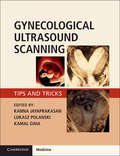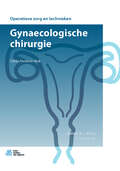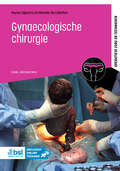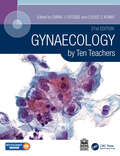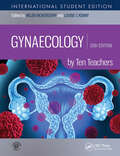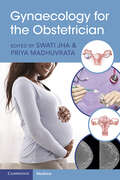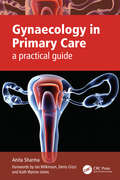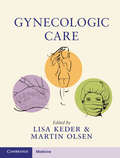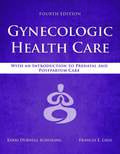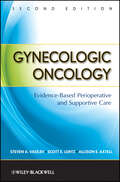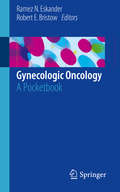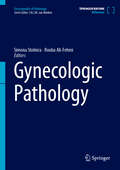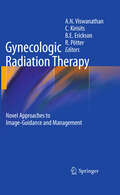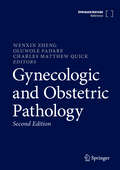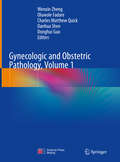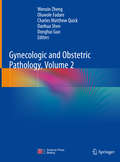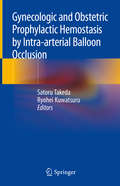- Table View
- List View
Guía de supervivencia de Científico en España
by Cientifico En EspañaUn libro tan divertido como real sobre todos los problemas y situaciones con las que se encuentra un científico a lo largo de su carrera, escrito por el investigador y tuitero más crítico, autocrítico e irónico de la Red. ¿Eres de esos a los que les gusta hacerse preguntas? ¿Te has planteado dedicarte a la ciencia? ¿Quieres saber cómo sobrevive un científico en su día a día en España? Quizás este libro pueda darte algunas respuestas..., aunque posiblemente no sean las que esperas.
Gymnastics Medicine: Evaluation, Management and Rehabilitation
by Emily SweeneyThis book presents the most current information on the treatment of athletes involved in gymnastics, a multifaceted sport with unique demands on its participants that can lead to a myriad of medical conditions and injury patterns. It opens with an introduction to the history of gymnastics and a brief review of gymnastics disciplines and events. An overview of gymnastics injury epidemiology lays the foundation for the rest of the book. Growth and developmental issues are also discussed in detail, as many young gymnasts train long hours before or during puberty. Concepts related to the biomechanics of gymnastics, common overuse and acute musculoskeletal injuries, psychological issues, concussions, as well as rehabilitation and return-to-play principles round out the presentation. Throughout, there is the emphasis that young athletes are not simply small adults, and that they have unique needs and considerations for evaluation and treatment. Written and edited by experts in the field, some of whom are former gymnasts themselves, Gymnastics Medicine covers all of the relevant information on evaluation, management and return-to-play for sports medicine physicians, advanced practice providers, physical therapists, athletic trainers, exercise scientists, and mental health professionals.
Gyn/Ecology: The Metaethics of Radical Feminism, with a New Intergalactic Introduction
by Mary DalyIn this book Daly argues that men throughout history have sought to oppress women. She moves beyond her previous thoughts on the history of patriarchy to the focus on the actual practices that, in her view, perpetuate patriarchy, which she calls a religion.
Gynaecological Cancer Care: A Guide to Practice (Ausmed Audiobooks Ser.)
by Tish Lancaster Kathryn NattressGynaecological cancers represent the second most common group of cancers and the most common cause of cancer death in woman, but the needs of women with gynaecological cancer are frequently unrecognised and often neglected. A diagnosis of gynaecological cancer can threaten a woman's body image, fertility, sexuality, femininity, relationships, and various roles in life. Nurses and other health professionals who care for women with gynaecological cancer require a resource that covers a range of issues in depth and breadth if they are to provide comprehensive care. This book offers a rich resource of material - presented in a stimulating style. It provides expert, practical, person-centred, evidence-based advice for nurses and other health professionals who care for women with gynaecological cancer.
Gynaecological Endoscopic Surgery: Basic Concepts
by Okechukwu Ibeanu Jude Ehiabhi Okohue Joseph Ifeanyichukwu Ikechebelu Bolarinde Ola Emmanuel KaluThis textbook embraces most aspects of gynaecological laparoscopy and hysteroscopy and it aims to present a comprehensive coverage of gynaecological minimal access surgeries with excellent medical illustrations. The reader is taken on a journey that includes the history of minimal access surgery, instrumentation and ergonomics required to progress in the field, capturing practical learning steps and navigating the reader through the diagnostic and therapeutic applications. In addition, it describes the latest technological advancement in the field, backed with high current best evidence. The authors are practicing specialists drawn from five continents who brought their wealth of experience and expertise to bear in this book. This textbook targets a global audience of practicing and trainee doctors in general gynaecology, subspecialists, and those with relevant special interests in gynaecological endoscopy surgery.
Gynaecological Oncology
by Mahmood I. Shafi Helena M. Earl Li Tee TanProviding a thorough and up-to-date overview of the full range of gynaecological cancers, Gynaecological Oncology is a concise introduction, particularly useful for trainees working towards postgraduate examinations. The first section includes introductory chapters on epidemiology, screening and prevention, imaging, pathology, surgery, radiation therapy, chemotherapy, and palliation. The second part of the book covers the gynaecological cancer types in turn; each chapter following a similar format looking at clinical issues, staging, and principles of management. Where appropriate, flow-charts and diagrams are used to help the reader assimilate complex information. A chapter is devoted to decision-making, addressing those issues clinicians and women face when deciding on optimal management in given clinical scenarios. The book is practically based and is enhanced by highlighting learning points, management algorithms and clinical images. This is an invaluable resource for all doctors and allied health professionals dealing with women with gynaecological cancers.
Gynaecological Oncology for the MRCOG
by Mahmood Shafi Helen Bolton Ketankumar GajjarWritten with the MRCOG examination requirements at its core, this book offers an extensive and up-to-date review of the full range of gynaecological cancers.<P><P> The principles of epidemiology, imaging and treatment modalities are presented in a succinct and clinically focused manner. Each gynaecological cancer features in a stand-alone chapter, incorporating information on clinical issues, staging and principles of management. Genetic conditions and surgical principles are analysed, as well as topics such as palliative care, holistic approaches and communication. RCOG guidelines and Scientific Advisory Committee advice feature throughout the book. While authoritative and factual, the text is concise and clear. Flow-charts and diagrams support the assimilation of complex information, while practical tips, management algorithms, and clinical images enhance each chapter. Essential for those preparing for the MRCOG examination, this book is a comprehensive resource for health professionals working with gynaecological cancers, and those who want to further understand gynaecological oncology.<P> The book is vital for the MRCOG examination with staging, statistics, management and outcomes for the full range of gynaecological cancers written in an easy-to-read format.<P> Includes the basics of epidemiology, imaging and treatment modalities, which previously were difficult to find written in a succinct and clinically focused manner.<P> RCOG guidelines and Scientific Advisory Committee material are used throughout the book to minimize conflicting advice in relation to clinical scenarios.<P> The latest staging guidelines are detailed and presented in pictorial format, enabling straightforward learning.
Gynaecological Oncology for the MRCOG and Beyond
by Nigel Acheson David LuesleyA multidisciplinary approach to the care of women with gynaecological cancer - with treatment delivered in linked local or specialist centres - has been established in the UK. The second edition of this book therefore includes chapters which focus on the multidisciplinary approach. Chapters on pathology, radiology, chemotherapy and radiotherapy will increase understanding of these disciplines that are central to the care of women with gynaecological cancers. Chapters on laparoscopic surgery, basic surgical principles, palliative care, emergencies and treatment-related complications provide additional information. All content has been updated to reflect current practice and present the latest evidence on investigation, staging and management. The book is primarily designed to provide a comprehensive summary for candidates preparing for the Part 2 MRCOG examination, and as such covers the RCOG curriculum for gynaecological oncology. It is also a valuable guide for all healthcare professionals working in the field, including trainees, consultants and midwives.
Gynaecological Ultrasound Scanning: Tips and Tricks
by Kanna Jayaprakasan Lukasz Polanski Kamal OjhaThis practical guide covers all aspects of gynaecological ultrasound, focusing on good technique, the ultrasound machine and reporting. Written by experts with a strong reputation for training in the field, this book takes a 'tips and tricks' approach. Chapters cover topics such as equipment familiarization, principles of transvaginal ultrasound, the awkward uterus, the difficult ovary, and ART-related procedures. The authors discuss the use of both basic ultrasound and 3D machines, and provide tips on how to optimize the image and gain useful clinical information even in the most challenging of assessments. With a multitude of images included to train the eye to identify normal anatomy and common pathologies, chapter summary boxes and case-based examples also provide an easy reference for assessing conditions and lesions. This book will greatly improve the scanning technique of trainees in obstetrics and gynaecology, sonographers, reproductive medicine practitioners, and gynaecologists of any level.
Gynaecologische chirurgie (Operatieve zorg en technieken)
by Myron Dijkstra Natalie de CallafonDit leerboek beschrijft de belangrijkste gynaecologische operaties en operatietechnieken. De basis wordt uitgebreid behandeld en het boek geeft achtergrondinformatie bij de verschillende ziektebeelden binnen de gynaecologische chirurgie. Het is bedoeld voor (aanstaande) operatieassistenten. Het boek is opgebouwd uit vier delen. Het eerste deel beschrijft de algemene basisrichtlijnen met betrekking tot vaginale operaties. Deel twee gaat over operaties met vaginale benadering. In deel drie worden de abdominale operaties besproken en in deel vier komen de laparoscopische operaties aan bod. Deze nieuwe editie van Gynaecologische chirurgie heeft een overzichtelijkere opzet. Ook zijn de meest recente ontwikkelingen en nieuwste operatietechnieken opgenomen. Tevens leest u over de meest voorkomende laparoscopische technieken waarbij een robot assisteert. Gynaecologische chirurgie is onderdeel van de reeks Operatieve zorg en technieken waarin verschillende chirurgische (sub-)specialismen worden behandeld.
Gynaecologische chirurgie (Operatieve zorg en technieken)
by Myron Dijkstra Natalie de CallafonDit leerboek biedt inzicht in de theoretische en praktische aspecten van de gynaecologische chirurgie. De algemene informatie en de beschreven pre-, per en postoperatieve fasen van de ingrepen dienen als voorbereiding op de praktijk voor operatieassistenten in opleiding en operatieassistenten die zich willen voorbereiden voor een gynaecologische ingreep. Dit boek kan tevens dienst doen als naslagwerk voor gediplomeerde operatieassistenten en professionals die direct of indirect met de operatieafdeling te maken hebben. Het boek is opgebouwd uit acht delen. Het eerste deel beschrijft de algemene principes en basisrichtlijnen van de gynaecologie. Tevens wordt de anatomie, fysiologie en pathologie van de vrouwelijke geslachtsorganen beschreven. Dit deel vormt de basis voor dit boek. In de daarop volgende delen worden de specifieke richtlijnen beschreven gevolgd door ingrepen. De delen zijn afzonderlijk van elkaar te lezen. Deel II bevat de operaties met vaginale benadering. In deel III worden de hysteroscopische operaties besproken. Deel IV behandelt de operaties met de abdominale benadering. Deel V begint met de inleiding van de obstetrie, gevolgd door de meest voorkomende ingrepen in de obstetrie. Deel VI behandelt de laparoscopische operaties en deel VII de robot geassisteerde operaties. Deel VIII biedt inzicht in het specifieke instrumentarium beschreven per categorie. Nieuw in deze geheel herziene druk zijn de hoofdstukken hysteroscopische operaties en obstetrie. De algemene richtlijnen zijn uitgebreid met informatie betreft het voortraject en diagnose stelling. De anatomische en fysiologische kennis is uitgebreider beschreven aangevuld met de pathologie. Deze editie van Gynaecologische chirurgie is aangepast naar de meest recente ontwikkelingen. De reeks ‘Operatieve Zorg en Technieken’ is bestemd voor de opleiding tot operatieassistent. Naast het basisboek bestaat de reeks uit een aantal vervolgdelen, waarin de verschillende chirurgische subspecialismen van de chirurgie worden behandeld. De reeks benadert de beroepsuitoefening van de operatieassistent zo dicht mogelijk, waarbij de talrijke gebruikte afbeeldingen de benaderingen onderbouwen.
Gynaecology by Ten Teachers
by Louise C Kenny Emma J CrosbieFirst published in 1919 as 'Diseases of Women', Gynaecology by Ten Teachers is well established as a concise, yet comprehensive, guide within its field. The 21st Edition has been thoroughly updated by its latest team of 'teachers', integrating clinical material with the latest scientific developments that underpin patient care. Each chapter is highly structured, with learning objectives, definitions, aetiology, clinical features, investigations, treatments and key point summaries and additional reading where appropriate. A key theme for this edition is 'professionalism' and information specific to this is threaded throughout the text. KEY FEATURES Fully revised – content is entirely refreshed and up to date for this 21st Edition, including the latest imaging and reproductive technologies and current guidelines for best practices Highly illustrated – text supported and enhanced throughout by high-quality colour line diagrams and photographs Clear and accessible – numerous features supplement the narrative text and provide useful queues for revision Illustrative case histories – engage the reader with realistic scenarios that bring obstetric practice to life Digital support material – download and personalise the ebook for fully flexible access and visit [www.routledge.com/cw/mccarthy] for additional resources including questions for self-assessment, video and patient interviews Along with its companion Obstetrics by Ten Teachers, 21st Edition, the books continue to provide an accessible 'one stop shop' in gynaecology and obstetrics and for a new generation of doctors.The editors:Emma J Crosbie is Professor of Gynaecological Oncology in the Division of Cancer Sciences at the University of Manchester and Consultant, Manchester University NHS Foundation Trust, Manchester, UK.Louise C Kenny is Professor and Executive Pro-Vice Chancellor of the Faculty of Health and Life Sciences at the University of Liverpool, UK.
Gynaecology by Ten Teachers
by Helen Bickerstaff Louise C KennyFirst published in 1919 as 'Diseases of Women', Gynaecology by Ten Teachers is well established as a concise, yet comprehensive, guide. The twentieth edition has been thoroughly updated by a new team of 'teachers', integrating clinical material with the latest scientific developments that underpin patient care. Each chapter is highly structured, with learning objectives, definitions, aetiology, clinical features, investigations, treatments, case histories and key point summaries and additional reading where appropriate. New themes for this edition include 'professionalism' and 'global health' and information specific to both areas is threaded throughout the text.
Gynaecology for the Obstetrician
by Swati Jha Priya MadhuvrataIn this era of specialisation, obstetricians are becoming increasingly skilled at their jobs and deskilled in areas outside their expertise. In recent years, the education and training curricula for obstetrics and gynaecology has changed, with obstetricians expected to manage women with complex gynaecological problems encountered during pregnancy and the postnatal period competently, despite training and curricula not covering these problems in detail. Exploring common gynaecological problems such as ovarian cysts, management of vaginal prolapse and female genital mutilation, this practical book offers guidance for managing these conditions throughout the different stages of pregnancy and post-partum. Each chapter has a section on good governance, discussing salient points for clinical practice to improve patient safety and satisfaction, as well as reducing complaints and litigation. This hands-on book provides obstetricians around the globe with the evidence-based knowledge needed to deliver high quality care to pregnant women.
Gynaecology in Primary Care: A Practical Guide
by Anita SharmaGynaecology in Primary Care comes at a time of great change in health service delivery. General practice is facing the challenges of developing Clinical Commissioning Groups, providing an ever greater range of primary care services and implementing NICE guidelines, whilst CCGs through their members will be under a legal duty to innovate. From a provider perspective, the book equips general practitioners with up-to-date knowledge of common gynaecological conditions, suggestions of best practice with regard to management and investigations to be undertaken within primary care, and guidelines for onward referral, where this is appropriate and necessary. From a commissioning perspective it provides an invaluable resource to CCGs, to inform their future pathways for gynaecology care. This highly practical book delivers the main aim of the RCP report - to ensure best care for female patients in the setting of their choice and where possible to develop streamlined one-stop services in primary care so that women do not have to take time off from their work and family commitments. It is ideal for general practitioners needing to be inspired and informed, and is also highly recommended for other healthcare professionals and medical students with an interest in women's health. 'Optimal patient care requires many connected features to synchronise effectively. This book describes how this could be achieved by focusing attention on well-crafted, evidencebased clinical pathways. This book advances our thinking on how we connect clinical, system and patient level perspectives on optimal care management.' Denis Gizzi, in his Foreword 'Written by a highly regarded, experienced and practicing GP, who has taken on the role as Clinical Director on behalf of the CCG for this programme area, this book is a valuable asset for both practicing GPs and developing CCGs to ensure that gynaecology services effectively commission, maximise the health of the population, improve the experience of the patient, and improve value for money.' Kath Wynne-Jones, in her Foreword 'An excellent guide to the management of gynaecological problems in primary care for not only clinicians in training, but for more experienced clinicians who look for straightforward and easily accessible advice to support their clinical management decisions. Look no further than this textbook. Dr Sharma's textbook will be a boon to developing organisations in delivering world-class services.' Dr Ian Wilkinson, in his Foreword
Gynecologic Care
by Martin E. Olsen Lisa KederGynecologic Care provides a succinct yet comprehensive discussion of critical knowledge required for gynecologists. Concise, easily accessible chapters allow the reader to quickly review essential material for patient care, or comprehensively study the modern management of gynecology. New residents can quickly cover the breadth of gynecology, while more experienced physicians will find the materials useful for review purposes. Each chapter covers key topics listed by the Committee for Resident Education in Obstetrics and Gynecology. Gynecologic Care is part of a three book series which covers the breadth of the Obstetrics and Gynecology specialty. The other books in the series are Obstetric Care and Office Care of Women.
Gynecologic Health Care: With an Introduction to Prenatal and Postpartum Care
by Kerri Durnell Schuiling Frances E. LikisAwarded second place in the 2021 AJN Book of the Year Awards in the Adult Primary Care categoryThe Gold Standard in Evidence-Based Gynecologic Health CareGynecologic Health Care: With an Introduction to Prenatal and Postpartum Care continues to set the standard for evidence-based gynecologic health care and well-being in an extensively updated fourth edition. As in prior editions, the text presents gynecologic health care using a holistic and person-centered approach. Encompassing both health promotion and management of gynecologic conditions, it provides clinicians and students with a strong foundation in gynecologic care and the knowledge necessary to apply it in clinical practice. With an emphasis on the importance of respecting the normalcy of physiology, it is an essential reference for all midwives, nurse practitioners, physician assistants, and other clinicians who provide gynecologic health care.Written by award-winning clinicians and educators, Gynecologic Health Care covers the topics clinicians and students need to know. Additional chapters provide an overview of prenatal and postpartum care, including anatomic and physiologic adaptations of normal pregnancy and common complications of pregnancy. The Fourth Edition features three new chapters: Racism and Health Disparities, Male Sexual and Reproductive Health, and Preconception Care. All chapters have been thoroughly revised and updated to reflect current standards of care Promotes a holistic approach that considers each patient’s well-being within the context of their life, rather than focusing only on diagnosis and treatment Expanded content supports the provision of gender-inclusive health care New chapters provide a foundation to help clinicians address racism and race-associated health disparities, provide sexual and reproductive health care to men, and ensure a comprehensive approach to preconception health promotion Contributors and reviewers are expert clinicians, educators, and scientists who recognize the importance of evidence-based practice Instructor resources include Powerpoint Lecture Slides and a Test Bank Reproductive and Women’s Health Advanced Health Assessment of Women Primary Care Women Sexual and Reproductive Health Women's Health II: Diagnosis & Mgmt In Advanced Nursing Practice Family Health Nursing III Health and Illness in Women Primary Health Care II Women Health Promotion and Reproductive Health Clinical Management Theory II Seminars in Advanced Women's Health © 2022 | 500 pages
Gynecologic Oncology
by Allison E. Axtell Steven A. Vasilev Scott E. LentzNew edition fully includes Grades and Levels of evidence, providing a better idea of what the sum total of existing evidence suggests regarding key topicsGrades and levels of evidence consistently highlighted throughoutGreater number of tables and algorithms ("decision trees") for key decision-making areas"Scope of concept" introduction to chapters are significantly enhanced, allowing the reader to reference the concepts while reviewing the specific details in the clinically oriented chaptersThe only available book with an evidence-based approach covering this specific subject matter in one compendium
Gynecologic Oncology
by Ramez N. Eskander Robert E. BristowDuring this age of advanced technology, there is an incredible amount of dynamic literature surrounding the diagnosis and treatment of gynecologic cancers. Despite this information surplus, house officers and junior faculty studying gynecologic oncology indicate a need for a reliable, easily accessible, streamlined resource for everyday use. Gynecologic Oncology: A Pocketbook is a collaborative effort that combines the perspectives of expert faculty and fellows in training in the field of gynecologic oncology. Not only is it incredibly portable, but the format in which the information is presented (bullet point, outline, tables and diagrams) allows for rapid access to valuable information and is unique amongst existing texts. This distinct pocketbook will provide the information needed to care for patients with gynecologic malignancies appropriately and will promote critical thinking throughout treatment.
Gynecologic Pathology (Encyclopedia of Pathology)
by Simona Stolnicu Rouba Ali-FehmiThis encyclopedia volume covers the complete field of gynecologic pathology – from Abnormal Villous Lesions to WHO Classification of Tumors of the Vulva. The alphabetically arranged entries, each of which provides a detailed description of a specific pathological disease pattern, allow readers to quickly and easily find the information they need.
Gynecologic Radiation Therapy
by Richard Pötter Akila N. Viswanathan Christian Kirisits Beth E. EricksonRecent advances in the treatment of gynecologic malignancies led to a new worldwide consensus to introduce image guidance to gynecologic radiation therapy, particularly to brachytherapy. The book summarizes the changed practice of management: treatment planning for cervical cancer, not modified for over 60 years, has been shifted to an image-based approach, endometrial cancer management with an increase in the use of chemotherapy and vaginal brachytherapy, and vaginal cancer therapy including image guidance and high-dose delivery with IMRT.
Gynecologic and Obstetric Pathology
by Oluwole Fadare Wenxin Zheng Charles Matthew QuickSince the first edition of the book “Gynecologic and Obstetric Pathology” was published in July 2019, the knowledge base of gynecologic and obstetric pathology advances very rapidly, especially in the areas of ancillary testing and classification of tumors. In addition, the publication of the WHO classification of Tumors of the Female Genital tract in 2020 introduced many changes in terminology, new variants of tumors and ancillary testing schema with several older entities were reclassified into other families of tumors, leading to diagnostic terminology that should no longer be utilized. Furthermore, multiple new entities and better diagnostic approaches have been recognized after the publication of WHO2020. In order to keep pace with these changes, this text must be updated to the new, worldwide standards in terminology to assure that it remains an authoritative text for gynecologic and obstetric pathology. This updated edition represents the most up to date, comprehensive text in this field, and a new edition will assure that this remains the case. Written by an international panel of well recognized, authoritative pathologists from numerous countries, it will be a helpful reference for practicing pathologists, pathology residents, gynecologic pathology and oncology fellows, clinicians, healthcare providers, and biomedical researchers and is intended for use as a bench or scope side reference, resource for studying for board examinations or to satisfy any interest in certain topics within the field of gynecologic pathology.
Gynecologic and Obstetric Pathology, Volume 1
by Oluwole Fadare Wenxin Zheng Charles Matthew Quick Danhua Shen Donghui GuoThis fully indexed, 2-volume book covers all aspects of gynecologic and obstetric pathology. It focuses on practical issues in each chapter by demonstrating pitfalls of diagnosis in addition to general criteria needed for each disease entity. As a reference book on gynecologic and obstetric pathology, it is targeted for practicing pathologists, pathology residents, gynecologic pathology and oncology fellows, clinicians, healthcare providers, and biomedical researchers and is intended for use as a bench or scope side reference, resource for studying for board examinations or to satisfy any interest in certain topics within the field of gynecologic pathology. Volume 1 contains 19 chapters covering disease entities of the vulva, vagina, cervix, and endometrium. It covers all the recognized recent advances within the field. Key diagnostic and differential diagnosis related points are illustrated in numerous tables. In addition, plenty of high quality pictures are presented for the vast majority of entities to facilitate both learning and teaching.
Gynecologic and Obstetric Pathology, Volume 2
by Oluwole Fadare Wenxin Zheng Charles Matthew Quick Danhua Shen Donghui GuoThis fully indexed, 2-volume book covers all aspects of gynecologic and obstetric pathology. It focuses on practical issues in each chapter by demonstrating pitfalls of diagnosis in addition to general criteria needed for each disease entity. As a reference book on gynecologic and obstetric pathology, it is targeted for practicing pathologists, pathology residents, gynecologic pathology and oncology fellows, clinicians, healthcare providers, and biomedical researchers and is intended for use as a bench or scope side reference, resource for studying for board examinations or to satisfy any interest in certain topics within the field of gynecologic pathology. Volume 2 contains 17 chapters covering disease entities of the uterine myometrium, ovary, fallopian tube, peritoneum, placenta, gestational trophoblastic diseases, and gynecology related cytology. It covers all the recognized recent advances within the field. Key diagnostic and differential diagnosis related points are illustrated in numerous tables. In addition, plenty of high quality pictures are presented for the vast majority of entities to facilitate both learning and teaching.
Gynecologic and Obstetric Prophylactic Hemostasis by Intra-arterial Balloon Occlusion
by Satoru Takeda Ryohei KuwatsuruThis book offers a highly informative guide to interventional radiology such as arterial embolization and arterial balloon occlusion for the prevention of massive hemorrhage and management of cervical myomectomy and cesarean hysterectomy. Recently, catheter intervention for hemostasis in obstetric patients has been increasingly used. Before myomectomy of large cervical leiomyoma or cesarean hysterectomy for placenta percreta with expected massive hemorrhage, a balloon occlusion catheter is inserted into arteries. In cesarean hysterectomy operations, ligation of internal iliac artery is not always effective in hemostasis of uterine bleeding: the success rate is about 40 -60%. Uterine blood flow during pregnancy is much different from that in non-pregnant women because large numbers of complicated collateral arteries develop during pregnancy, especially in patients with placenta previa. If the internal iliac artery and hypogastric artery are ligated, peripheral blood flow is still maintained, which causes intraoperative problems. The authors argue that effective transcatheter balloon occlusion requires a detailed knowledge of blood flow in both pregnant and non-pregnant women. As such the book provides extensive, detailed anatomical figures and videos offer readers vivid insights into methods of intercepting the uterine blood supply and the surgical methods. The book offers a new and indispensable reference guide for all obstetricians, not only for residents, but also for experienced professionals. It is also a valuable resource for radiologists and radiological technicians and radiology specialists.
